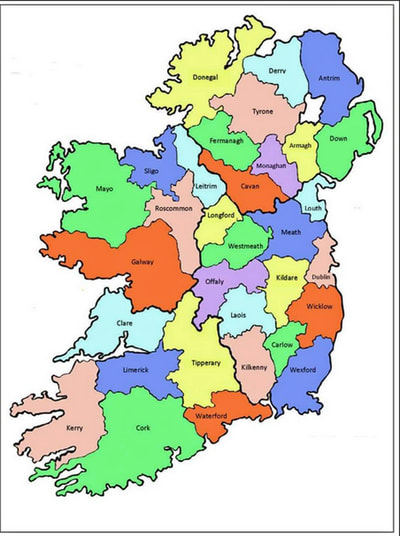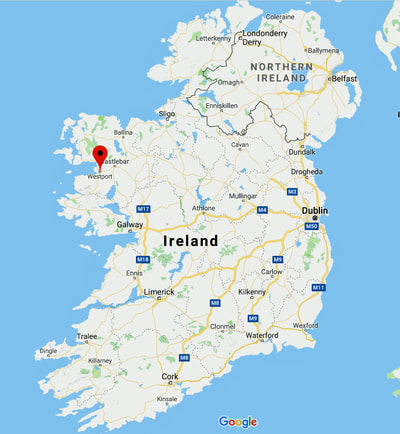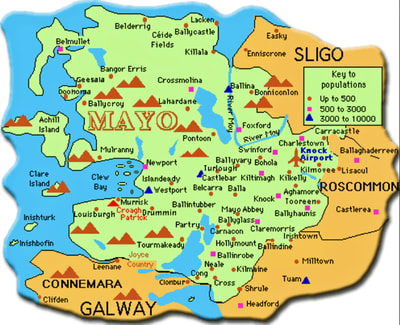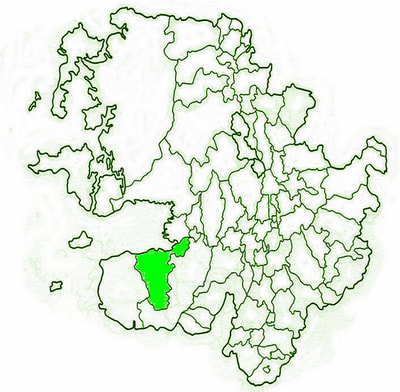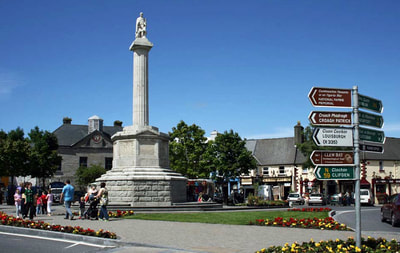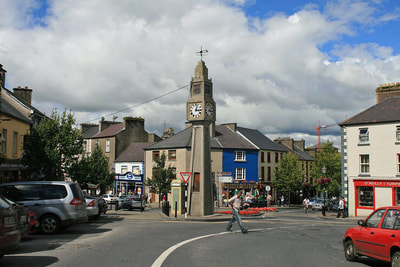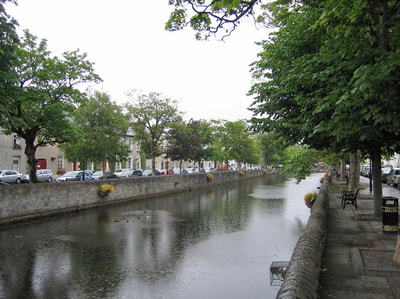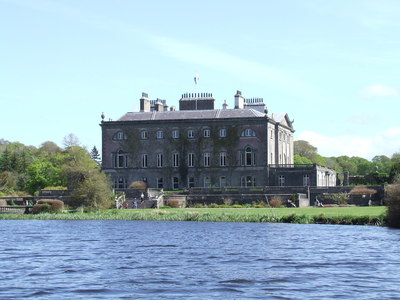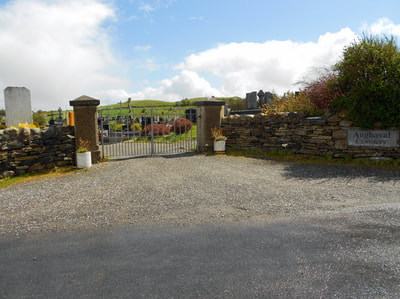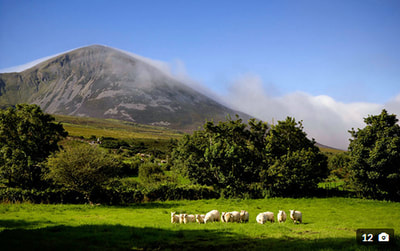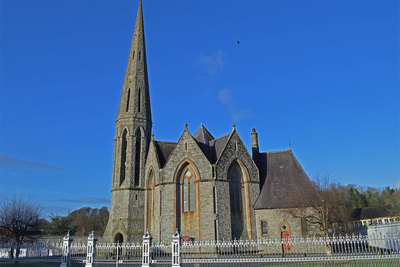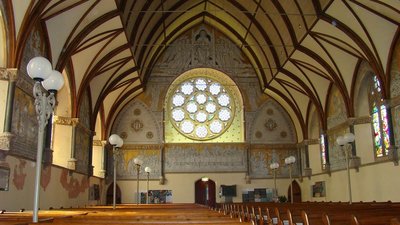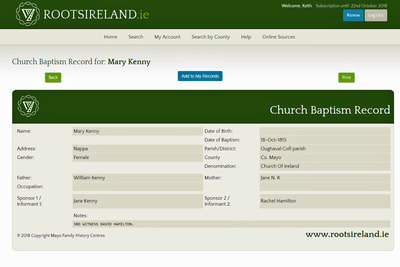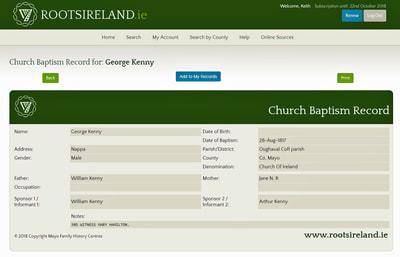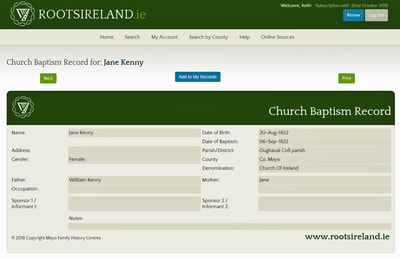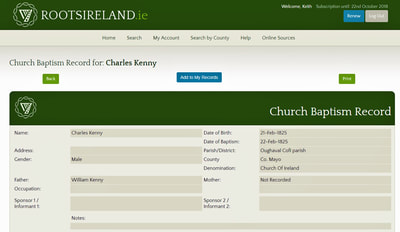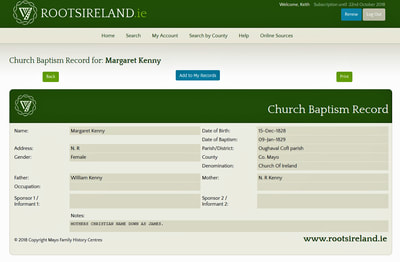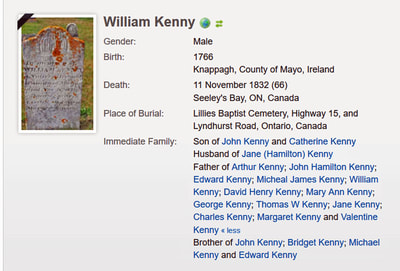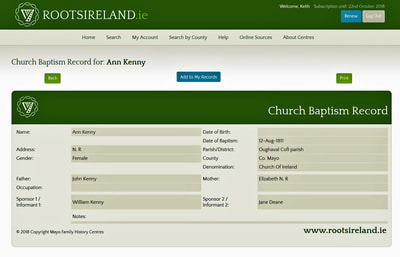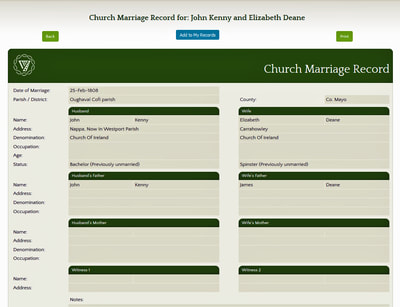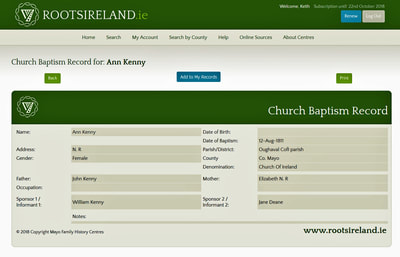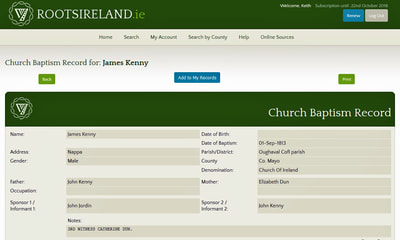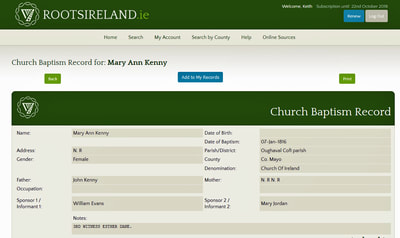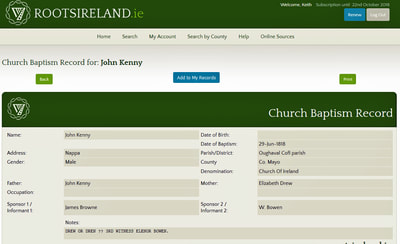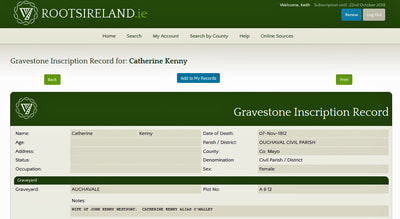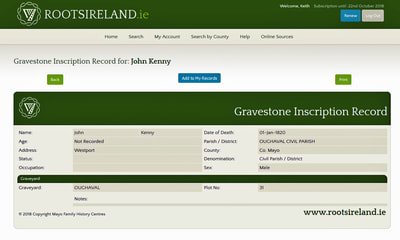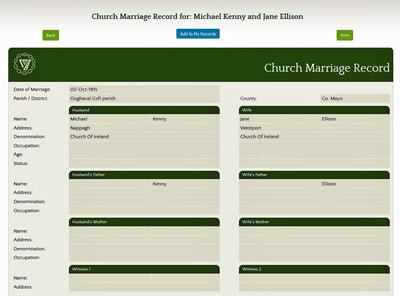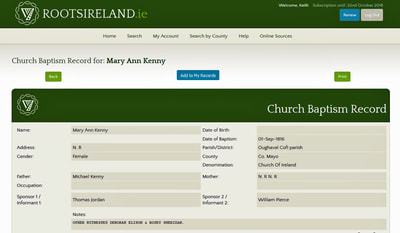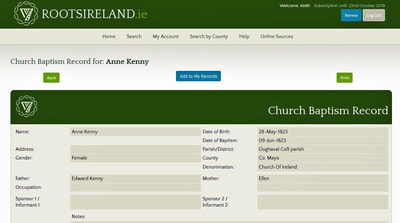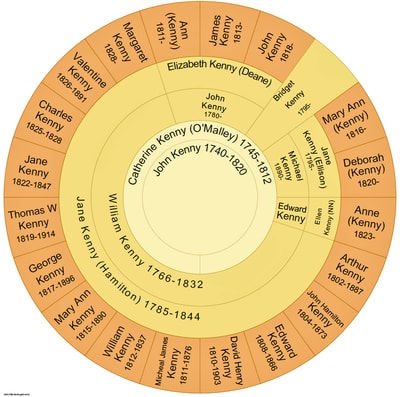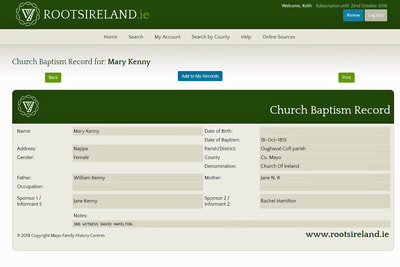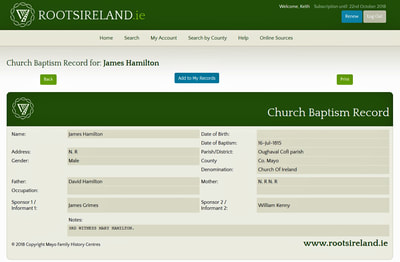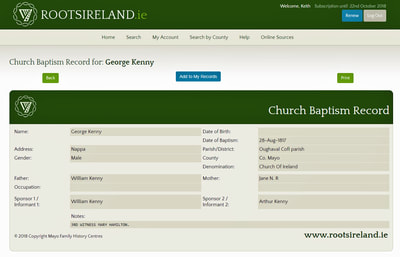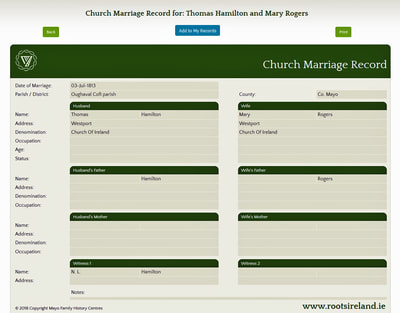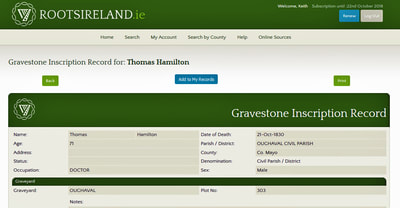Author: Keith Millard
October 2018
Note: My great grandmother was Mary Eliza Kenny, a great granddaughter of William Kenny
October 2018
Note: My great grandmother was Mary Eliza Kenny, a great granddaughter of William Kenny
County Mayo - in 18th & 19th Centuries:
For the vast majority of people in County Mayo the eighteenth century was a period of unrelieved misery, with some minor famines. Because of the operation of what were called 'the penal laws', Catholics had no hope of social advancement while they remained in their native land.
Culturally, 19th century Mayo made some contribution to the "hidden Ireland" of the time, and two Mayo-born poets from the period have retained considerable popularity: Riocard Bairéad (d. 1819) from the Mullet, whose songs included 'Eoghan Cóir', 'Preab san l', and 'Tarraingt na Móna' and blind Anthony Raftery (d.1835) from Killedan, near Kiltamagh (alias Kiltimagh) , who spent most of his life in south and east Galway, and whose numerous compositions included the ever-popular 'Máire Ní Eidhin', 'Aithrí Reaftaraí' and, of course, 'Cill Liadáin'.
The early decades of the 19th century saw a new outbreak of agrarian agitation with the rise of the 'Ribbon Societies' in Connacht. These sought to protect tenants against eviction by landlords who wished to clear their lands for grazing - to avail of the high prices for cattle prevailing in the years immediately after the Napoleonic Wars. Ribbonism had a strong sectarian tinge, being influenced by inflammatory pamphlets which were widely circulated at the time and which predicted the imminent overthrow of 'the Reformation'.
Early in the nineteenth century, there were a number of famines in Ireland, culminating in the Great Famine of 1845 - '49, when about a million people died and a further million went into exile.
Hover for caption, click on images to enlarge or to navigate:
Culturally, 19th century Mayo made some contribution to the "hidden Ireland" of the time, and two Mayo-born poets from the period have retained considerable popularity: Riocard Bairéad (d. 1819) from the Mullet, whose songs included 'Eoghan Cóir', 'Preab san l', and 'Tarraingt na Móna' and blind Anthony Raftery (d.1835) from Killedan, near Kiltamagh (alias Kiltimagh) , who spent most of his life in south and east Galway, and whose numerous compositions included the ever-popular 'Máire Ní Eidhin', 'Aithrí Reaftaraí' and, of course, 'Cill Liadáin'.
The early decades of the 19th century saw a new outbreak of agrarian agitation with the rise of the 'Ribbon Societies' in Connacht. These sought to protect tenants against eviction by landlords who wished to clear their lands for grazing - to avail of the high prices for cattle prevailing in the years immediately after the Napoleonic Wars. Ribbonism had a strong sectarian tinge, being influenced by inflammatory pamphlets which were widely circulated at the time and which predicted the imminent overthrow of 'the Reformation'.
Early in the nineteenth century, there were a number of famines in Ireland, culminating in the Great Famine of 1845 - '49, when about a million people died and a further million went into exile.
Hover for caption, click on images to enlarge or to navigate:
Oughaval Parish:
AUGHAVAL, or OUGHAVAL, a parish, in the barony of MURRISK, county of MAYO, and province of CONNAUGHT; containing, with the market and post-town of Westport, 13,921 inhabitants. The above is from the Topographical Dictionary of Ireland by Samuel Lewis, 1837, with a full description of the Oughaval parish. To see the full report, see instructions below the images section below.
The earliest habitation of the Westport area was 5,000 years ago. Its Irish name is Cathair na Mart, or stone fort of the cattle. In the 16th century Cathair na Mart was an important O’Malley stronghold at the head of Clew Bay; it was burned by the governor of Connacht in 1583. During the 17th century Cathair na Mart passed from the O’Malleys to the Browne family.
The principal town in the parish is Westport (Irish: Cathair na Mart, meaning "stone fort of the beeves", historically anglicised as Cahernamart), with a current population of just over 27,000.
The current Westport town centre was originally designed by William Leeson in 1780, in the Georgian architectural style. Its layout follows the medieval principles of urban design introduced by the Normans in the 13th century. A particular feature is the incorporation of the river into the composition, contained for two blocks by low stone walls producing, on each side of the river, tree lined promenades (The Mall) with several stone bridges over the river Carrow Beg. The layout further includes several tree lined streets, addressed by the narrow fronted commercial buildings typical of Irish towns, though with many here remaining of a singular refinement and charm.
Hover for caption, click on images to enlarge or to navigate:
The earliest habitation of the Westport area was 5,000 years ago. Its Irish name is Cathair na Mart, or stone fort of the cattle. In the 16th century Cathair na Mart was an important O’Malley stronghold at the head of Clew Bay; it was burned by the governor of Connacht in 1583. During the 17th century Cathair na Mart passed from the O’Malleys to the Browne family.
The principal town in the parish is Westport (Irish: Cathair na Mart, meaning "stone fort of the beeves", historically anglicised as Cahernamart), with a current population of just over 27,000.
The current Westport town centre was originally designed by William Leeson in 1780, in the Georgian architectural style. Its layout follows the medieval principles of urban design introduced by the Normans in the 13th century. A particular feature is the incorporation of the river into the composition, contained for two blocks by low stone walls producing, on each side of the river, tree lined promenades (The Mall) with several stone bridges over the river Carrow Beg. The layout further includes several tree lined streets, addressed by the narrow fronted commercial buildings typical of Irish towns, though with many here remaining of a singular refinement and charm.
Hover for caption, click on images to enlarge or to navigate:
This is a pdf file from the Topographical Dictionary of Ireland by Samuel Lewis, 1837, with a full description of the Oughaval parish;
Right click on Download File, then click on Open link in new window.
Right click on Download File, then click on Open link in new window.
| topographical_dictionary_of_ireland_by_samuel_lewis_1837.pdf |
Church of the Holy Trinity:
We note there are no Oughaval Cofl parish records available before about 1810. Old texts state "the old parish church built in 1797 that now lies in ruins beside the Carrowbeg River" - the 1st clue here is that it was right by a river and probably prone to flooding, 2nd is "the old parish church which was in the demesne of Westport House, built we know not when, rebuilt in 1797, and now in ruins".... this implies the very old parish church was destroyed or partially ruined before 1797, and this explains the permanent absence of any parish records before 1797 as well as none before the completion of the rebuilding started in 1797, in about 1810.
Almost as astonishing is the almost total lack of records after about 1830, and one can suppose floods or fire once again took care of this rebuilt church.
Finally, a new Church of the Trinity church was built in 1868 some distance away from the old church site by the Carrowbeg River.
Hover for caption, click on images to enlarge or to navigate:
Almost as astonishing is the almost total lack of records after about 1830, and one can suppose floods or fire once again took care of this rebuilt church.
Finally, a new Church of the Trinity church was built in 1868 some distance away from the old church site by the Carrowbeg River.
Hover for caption, click on images to enlarge or to navigate:
William Kenny – Genealogy Report:
Research in County Mayo records prove conclusively that the William Kenny family lived in Oughaval Cofl parish at Westport in Ireland. A family named Hamilton also lived in this parish, and there is ample reason to believe both families had lived there for some time, likely several generations.
All of the birth, marriage, and death records for County Mayo (in RootsIreland) were examined individually and it appears certain the only Kenny or Hamilton records of value to this research were those in the Oughaval Cofl parish.
There are a number of things we can piece together from the records that are available, not the least of which is there was likely only one person reported as William Kenny in the parish, and also highly likely the other Kenny and Hamilton children baptized in the 1806 - 1828 available parish records were an integral part of these two families.
We can start with the baptism records we have found for the children of William Kenny and Jane Hamilton.
Hover for caption, click on images to enlarge or to navigate:
All of the birth, marriage, and death records for County Mayo (in RootsIreland) were examined individually and it appears certain the only Kenny or Hamilton records of value to this research were those in the Oughaval Cofl parish.
There are a number of things we can piece together from the records that are available, not the least of which is there was likely only one person reported as William Kenny in the parish, and also highly likely the other Kenny and Hamilton children baptized in the 1806 - 1828 available parish records were an integral part of these two families.
We can start with the baptism records we have found for the children of William Kenny and Jane Hamilton.
Hover for caption, click on images to enlarge or to navigate:
William Kenny's siblings & Parents:
We can start with the birth of Ann Kenny in 1811, her baptism record shows her mother’s name was Elizabeth and her father was John Kenny, and the two witnesses were William Kenny and Jane Deane.
Hover for caption, click on images to enlarge or to navigate:
Hover for caption, click on images to enlarge or to navigate:
Now we can back up one step to the 1808 marriage of John Kenny (son of John Kenny) and Elizabeth Deane. It is quite easy to stipulate this John Kenny is most likely a brother (perhaps younger) to William Kenny, and therefore William Kenny’s and John Kenny’s father was this same John Kenny.
Hover for caption, click on images to enlarge or to navigate:
Hover for caption, click on images to enlarge or to navigate:
There are birth records for four of John and Elizabeth’s children, Ann in 1811 (already displayed above), as well as James born in 1813, Mary Ann born in 1816, and John in 1818.
Hover for caption, click on images to enlarge or to navigate:
Hover for caption, click on images to enlarge or to navigate:
Next, let’s look at the 1812 death of Catherine Kenny, and her burial inscription states she was the wife of John Kenny and that her maiden name was O’Malley. These were William Kenny’s parents, and John Kenny died in 1820.
Hover for caption, click on images to enlarge or to navigate:
Hover for caption, click on images to enlarge or to navigate:
Next is the 1806 marriage of Bridget Kenny to Charles O’Hara, and Bridget was the daughter of John Kenny, therefore a sister to both John and William Kenny.
And next is the 1815 marriage of Michael Kenny, very likely also a sibling to William, Bridget, and John Kenny.
Michael and Jane have two recorded children, Mary Ann Kenny born in 1816, and Deborah Kenny born in 1820.
Last but not least is Edward Kenny, for whom we can’t find a birth or a marriage record, but a birth record for Anne Kenny, born in Oughaval Cofl in 1823. An assumption is made that he is also a sibling to William, John, Michael, etc.
Hover for caption, click on images to enlarge or to navigate:
And next is the 1815 marriage of Michael Kenny, very likely also a sibling to William, Bridget, and John Kenny.
Michael and Jane have two recorded children, Mary Ann Kenny born in 1816, and Deborah Kenny born in 1820.
Last but not least is Edward Kenny, for whom we can’t find a birth or a marriage record, but a birth record for Anne Kenny, born in Oughaval Cofl in 1823. An assumption is made that he is also a sibling to William, John, Michael, etc.
Hover for caption, click on images to enlarge or to navigate:
The Kenny/Hamilton Connections:
And now, the Hamilton connection; we know that William Kenny was married to Jane Hamilton, and we’ll start by looking at the birth record for their daughter Mary Kenny born in 1815; what we see here is that two of the witnesses for this baptism were David Hamilton and Rachel Hamilton, presumed to be either parents or siblings of Jane Hamilton.
Hover for caption, click on images to enlarge or to navigate:
Hover for caption, click on images to enlarge or to navigate:
Next up are the 1815 baptisms of James Hamilton, son of David Hamilton and witnessed by William Kenny, followed by the 1817 baptism of George Kenny, son of William Kenny and Jane Hamilton, and witnessed by Arthur Kenny and by William Kenny, but also by Mary Hamilton, suspected to also be a sister of Jane Hamilton.
This again proves the closeness of the two families.
Hover for caption, click on images to enlarge or to navigate:
This again proves the closeness of the two families.
Hover for caption, click on images to enlarge or to navigate:
Now we are going to look at a couple of other Hamilton records, first being the baptism of Edward Hamilton, born 1820, to David and Rachel Hamilton. Again, we believe David may be Jane Kenny’s brother.
Second, is the marriage record of Thomas Hamilton to Mary Rogers in 1813, whom we expect to be a brother both to David Hamilton and to Jane Hamilton (wife of William Kenny).
Last but not least, here is the 1830 burial inscription for Dr Thomas Hamilton, believed to be the father of Jane Hamilton, David Hamilton, and Thomas Hamilton.
Hover for caption, click on images to enlarge or to navigate:
Second, is the marriage record of Thomas Hamilton to Mary Rogers in 1813, whom we expect to be a brother both to David Hamilton and to Jane Hamilton (wife of William Kenny).
Last but not least, here is the 1830 burial inscription for Dr Thomas Hamilton, believed to be the father of Jane Hamilton, David Hamilton, and Thomas Hamilton.
Hover for caption, click on images to enlarge or to navigate:
It is reasonable to believe that Jane Hamilton’s father WAS a doctor (as has been rumored), that William Kenny’s father was, in fact, the John Kenny shown above, and that Catherine O'Malley was William Kenny's mother.
Other opinions are welcomed, as are photos that can be added to this essay!
Other opinions are welcomed, as are photos that can be added to this essay!
